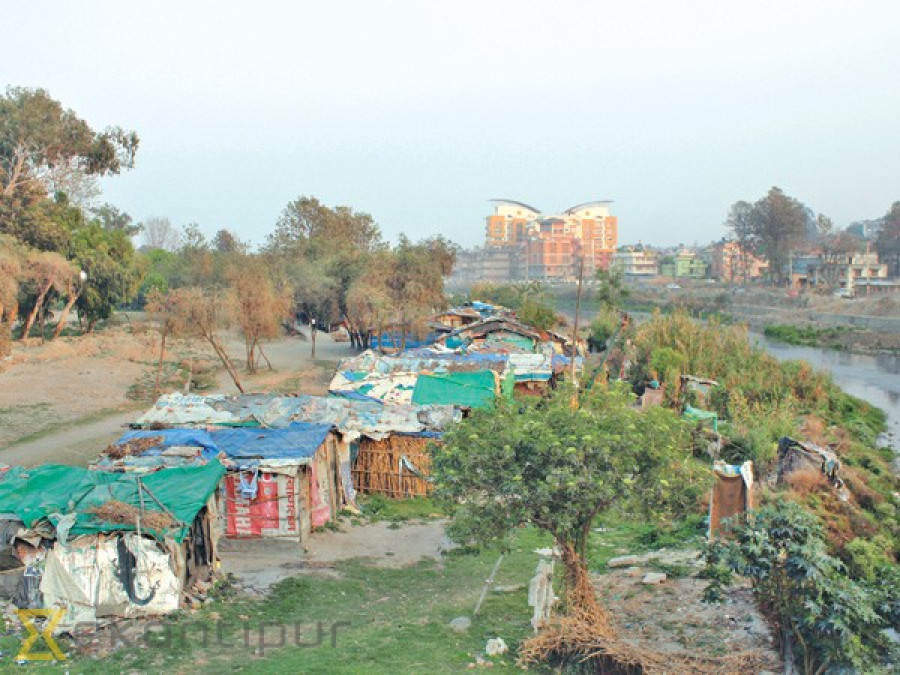Opinion
No place to call home
Informal settlements in Kathmandu continue to be under supported
Narayan Prasad Bhatta
The term sukumbasi is often pejoratively used to describe ‘slum-dwellers’ in Nepal. For many people in Kathmandu, the term conjures up images of land grabbers and river polluters. But have they actually taken the time to consider what life is like inside these settlements? Nobody would live by choice in a location that is vulnerable to natural disasters and evictions.
Informal settlements vary greatly in their size and location and in the way they are formed. Informal settlements have increasingly emerged as one of the principle features of cities in many third world countries. It is complex and diverse in a variety of ways, such as in their physical form, the nature of poverty, vulnerability, social problems within the settlement, and the rural linkages of residents.
Although informal settlements can be cohesive and tightly knit, there are often severe social problems caused by poverty and vulnerability, and by a general sense of social exclusion. In Nepal, the proliferation of informal settlements is associated with the urban-rural migration influx, cross-border migration and inherent socio-economic disparity aggravated by soaring costs of lands and housing and rising unemployment among others.
The Bagmati river bank, in particular, has been experiencing a tremendous rise in the number of inhabitants over the years. It has been found that there are a total of 13 informal clusters comprising around 5406 families. In the past decade, many in-migrants had been displaced from the countryside as a result of political conflicts. In the city, they started encroaching on public land, especially around the Bagmati riverbanks. Communities residing in these areas have had to address various issues of housing, environment, community, heritage conservation, land management, solid waste management, to name a few.
Generally, slum dwellers have no place to socialise and to exercise their agency as independent agents. Given this, steps should be taken to provide standard living conditions. Access to land is the greatest single obstruction to the improvement of informal settlement living conditions.
Since the last three decades, developed land is scarce in Kathmandu. Hence, slum dwellers struggle to access even the smallest amount of land in the limited available plots by riverbanks.
Nepal holds one of the highest urban population growth rates in South Asia, estimated at around 7 percent in the early part of the decade. The growth of manufacturing and services, which are predominantly urban in character, has been more than double that of the rural economy. Yet the urban economy operates under service constraints in Nepal. Hence, a key challenge going forward is that of maximising the economic opportunities offered by urbanisation and agglomeration while securing environmental sustainability and social equity. There are still thousands of people who, because of socio-economic reasons, are unable to build a house and therefore have to resort to settlements. According to documents published by the Kathmandu Metropolitan City, Nepal’s housing stock is approximately 4 million units and a half percent of them are of very low quality.
To address the issue and improve the living conditions found in informal settlements, the following recommendations should be considered. First, settlements require basic infrastructural interventions including access to safe drinking water supplies, the building of surface drains, foot tracks and the development of a solid waste management system.
In view of existing practices, communities should also be oriented on the importance of drinking safe water and should be made aware of effective health and sanitation practices. Municipalities and non-government agencies should work closely together to increase the level of awareness on proper health practices. Second, developmental measures should adopt bottom-up approaches to ensure that settlers are involved in intervention processes.
Through the entire planning process, they have demonstrated their capacity to develop viable solutions and to prepare themselves to fight for shelter rights by organising themselves and planning settlements to build a better live for their families and communities. Third, the state should consider an employment scheme for settlers as a long-term strategy. By hiring settlers, the state would in turn be providing income to a familial unit—and not the individual alone—and will thereby contribute to long-term change in the family.
Fourth, non-governmental organisations should also consider opening public shelters in rented housing quarters; this way, settlers will be given the basic foundation to improve their livelihood by focusing on securing employment rather than trying to simply make ends meet. And finally, the issue warrants more in-depth studies to determine slum dwellers’ root needs in order to devise a sustainable solution in the Kathmandu context.
Bhatta holds a PhD in rural development from Tribhuvan University.




 8.12°C Kathmandu
8.12°C Kathmandu










